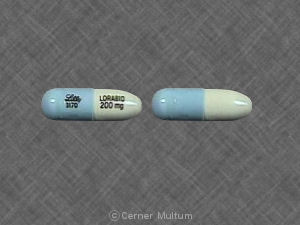Lorabid Pulvules and Alcohol/Food Interactions
There is 1 alcohol/food/lifestyle interaction with Lorabid Pulvules (loracarbef).
Loracarbef Food/Lifestyle
Moderate Food Interaction
ADJUST DOSING INTERVAL: Loracarbef may exhibit reduced gastrointestinal absorption in the presence of food. When loracarbef capsules were administered with food, the peak plasma concentrations were 50% to 60% of concentrations after administration in a fasting state and were reached 30 to 60 minutes later. Area under the concentration-time curve (AUC) was not affected. The therapeutic effect of the antimicrobial may be reduced.
MANAGEMENT: Loracarbef should be administered at least one hour before or two hours after eating.
References (1)
- (2002) "Product Information. Lorabid (loracarbef)." Lilly, Eli and Company
Switch to consumer interaction data
Lorabid Pulvules drug interactions
There are 46 drug interactions with Lorabid Pulvules (loracarbef).
Lorabid Pulvules disease interactions
There are 4 disease interactions with Lorabid Pulvules (loracarbef) which include:
More about Lorabid Pulvules (loracarbef)
- Lorabid Pulvules consumer information
- Check interactions
- Compare alternatives
- Drug images
- Side effects
- Dosage information
- During pregnancy
- Drug class: second generation cephalosporins
- Breastfeeding
Related treatment guides
Drug Interaction Classification
| Highly clinically significant. Avoid combinations; the risk of the interaction outweighs the benefit. | |
| Moderately clinically significant. Usually avoid combinations; use it only under special circumstances. | |
| Minimally clinically significant. Minimize risk; assess risk and consider an alternative drug, take steps to circumvent the interaction risk and/or institute a monitoring plan. | |
| No interaction information available. |
See also:
Further information
Always consult your healthcare provider to ensure the information displayed on this page applies to your personal circumstances.


